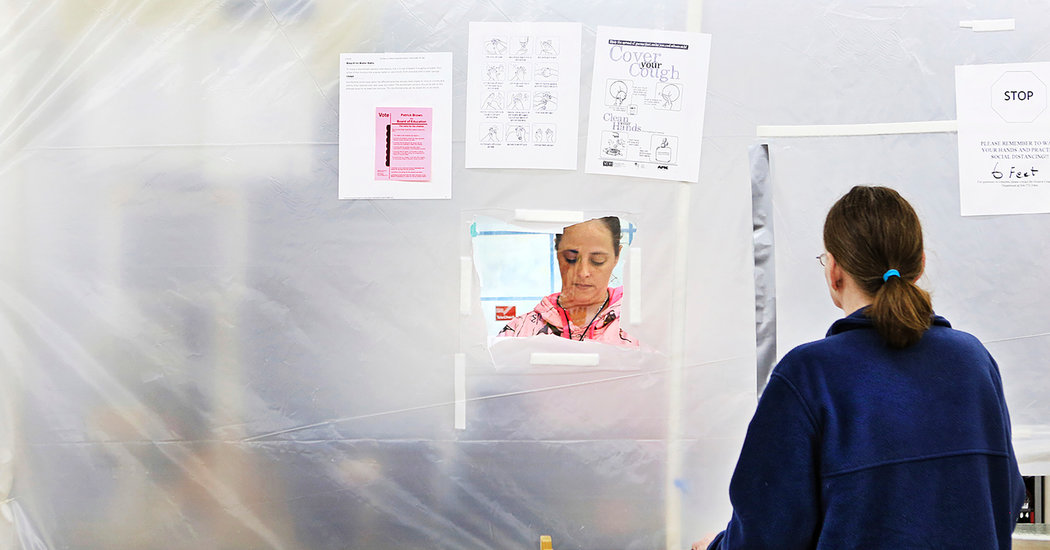[ad_1]
Democrats and Republicans differ on attitudes toward coronavirus risks and in workplace behaviors meant to reduce them, according to a new survey. This partisanship has the potential to hurt efforts to stop the spread of the virus.
The data from Gallup’s Covid-19 tracking panel shows that people deemed essential workers are generating large numbers of close contacts with other people, putting themselves and those they live with at risk. Recognizing this, most workers have changed how they do their jobs to reduce the risk of viral transmission.
Yet workers living in counties won by President Trump in the 2016 election are slightly less likely to have adopted these changes, with Republicans living in those counties even less likely to have done so.
Over several weeks in April, the survey shows, essential workers generated 22 contacts per day compared with only four per day for nonessential workers. (Contacts were defined as the number of people a respondent came within six feet of.) As expected, the workplace accounted for more of the essential workers’ contacts than any other location. But the workplace was the site of hardly any contacts for nonessential workers, most of whom are working from home, if at all.
Over all, essential workers are not taking the risks of transmission lightly. The majority (55 percent) say they are moderately or very concerned about being exposed to the virus at work. Eighty percent of essential workers say they have changed how they do their work to lower the risk of transmission — and those who say they have made such changes generate fewer close contacts than those who haven’t. These efforts include trying to maintain at least six feet of distance from customers and co-workers, using masks and gloves, and adopting new and more frequent cleaning practices.
Yet these attitudes also vary by political geography. Essential workers who identify with the Democratic Party are more likely to be concerned about getting the virus (66 percent) than their Republican Party counterparts (45 percent). They also have far greater confidence in social distancing. Three out of four (73 percent) essential workers who affiliate with the Democratic Party say that they are very confident that social distancing saves lives, compared with 27 percent of essential workers who identify as Republicans.
For members of both parties, living in a county won by the president substantially reduces confidence in social distancing. Democrats living in counties won by Mr. Trump are 15 percentage points less likely to say they are very confident that social distancing saves lives compared with Democrats living in counties won by Hillary Clinton.
These partisan differences are predictive of actual worker behavior, although with a more modest effect.
Republican workers in Trump counties are less likely than their Republican counterparts in Clinton-won counties to say they have made changes to avoid transmission (74 percent versus 82 percent), and both groups are less likely to say they have made changes than Democrats in Trump-won counties (85 percent) or Clinton-won counties (89 percent). The use of personal protective equipment at work fits the same pattern.
The pattern doesn’t always hold perfectly. Most Republican workers in Trump-won counties report trying to maintain at least six feet of distance from customers and co-workers (55 percent). That’s higher than the rate for Republicans in Clinton-won counties (47 percent), but it’s still well below Democrats in Clinton-won counties (70 percent).
One potential explanation for the partisan patterns is that some Republican Party leaders or media pundits are playing down the severity of the risks. Another is that population density and the number of confirmed cases and deaths are lower on a per-capita basis in the counties won by President Trump. But in the data, there is no significant correlation between county disease prevalence and adoption of these countermeasures.
Moreover, while cases and deaths have been lower in Trump-won counties, the growth rate in new cases since April 11 is roughly the same in Trump-won and Clinton-won counties, suggesting that the need to reduce transmission could be just as urgent in these areas.
As debates go on about when and how to reopen the economy, essential workers and their employers are developing best practices to combat the spread of coronavirus. But it will be hard to do so without cooperation and collective action across diverse communities. Because the virus knows no borders, outbreaks in liberal areas will put conservative areas at risk and vice versa.

















